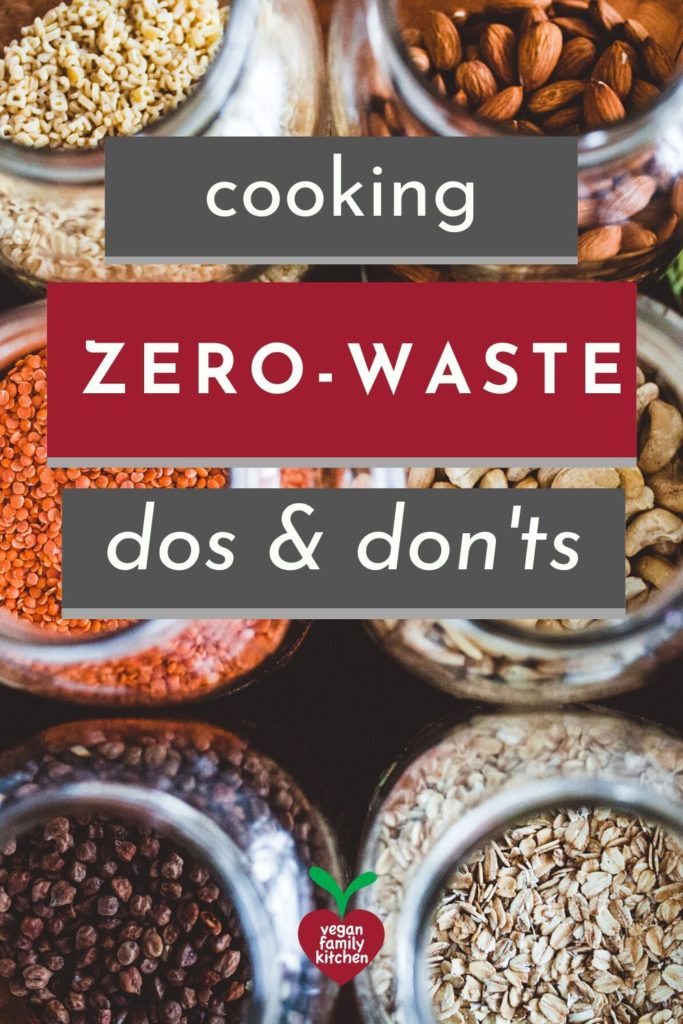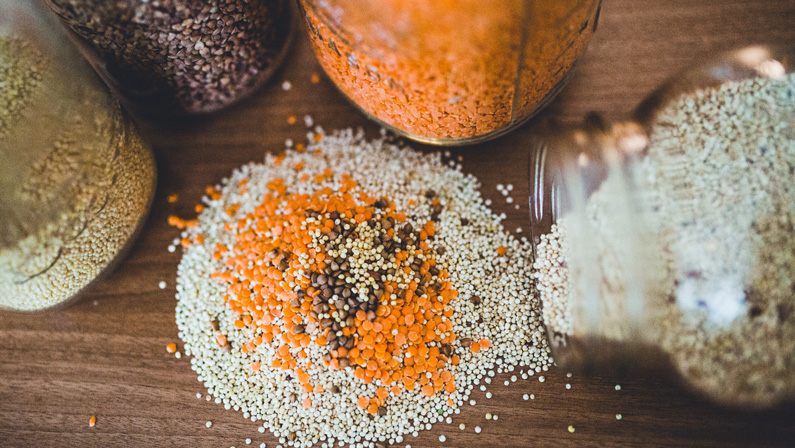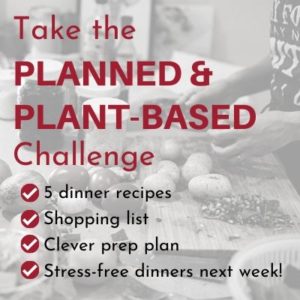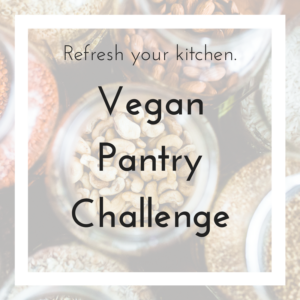Eating is unavoidable if we are to stay alive, but certainly there are less wasteful ways to do it. Drastically cutting back on meat, dairy, and egg consumption was something I did at first for environmental reasons. But once my family ate mostly plant-based meals, I wondered: what else can I do to reduce our footprint? In this post, I explore zero-waste cooking for vegans. I list the dos and don’ts my family is experimenting with as an effort to cutback on unnecessary waste. Here’s a hint: convenience is often the culprit when it comes to waste. Slowing down, thinking ahead, and perhaps doing less are keys to a lower-waste lifestyle.
Plan to cook at home, mostly from scratch
Home-cooked plant-based meals will practically always result in less waste overall than restaurant fare (delivery or take-out), to say nothing of the fact that they’ll also be far cheaper and healthier. Restaurant operations are inherently wasteful, and packaging is required to bring the food from their kitchen to your table. Even biodegradable containers have negative side effects (they release greenhouse gases when decomposing) and few cities have the infrastructure required to deal with compostable ware. Many food containers are “wish-cycled” by well-intentioned citizens, only to contaminate the stream of legitimate recyclables.
Cooking does take some time, but often not that much longer than ordering, as long as one has a decently-stocked pantry. There are many meals you can improvise with whatever you have at hand. Better yet, plan your meals ahead of time to avoid the sirens of convenience: it’s easier to make the right decision ahead of time, when we are relaxed, than at 6 pm on a Friday night when we are famished after a long stressful week. (Need help with meal planning? Learn the basics, download one of my easy templates, or subscribe to the Vegan Family Meal Plans.)
Caring for leftovers (and actually eating them!)
The abandonment of cooked food is a tragedy. So much effort, energy, and love go into growing, harvesting, transforming, and ultimately cooking food that letting the leftovers rot should be treated as a crime. We make sure to transfer leftovers to containers and refrigerate or freeze immediately after dinner. Most can be combined to create suitable lunches. Some make a fine snack or perhaps a side dish for a meal in the near future.
My family prefers rectangular glass containers with snap tops because we can transfer hot food to them. They are see-through and use space most efficiently in the fridge, in addition to being freezer- and oven-friendly. (Check your containers to be safe.)
Don’t forget to use labels and consider keeping an inventory of your freezer’s content.
Pantry organization is everything
As a curious cook, I used to buy so many different ingredients from various culinary traditions… and my pantry was a mess! Rolled-up bags and open boxes of flours, powders, and seasonings cluttered my kitchen cabinets… until inevitably I was hit with a pantry moth infestation. (That is *serious* food waste.)
Now, everything gets stored into airtight, labelled glass jars. If there isn’t room for another jar, and I can’t find the ingredient in a small-enough quantity just for the recipe I want to make… then I am not making it! The jar system, combined with pull-out drawers, means that I can see what ingredients I have at a glance, and plan my meals (or improvise a feast) accordingly. When I dip in a jar and see that the content is getting on the low side, I immediately add it on the list for my next trip to the bulk store.
What vegan ingredients I buy in bulk
Dry beans of all types, peas, and lentils are easy to find in bulk at practically any grocery store. I prefer to cook my own from scratch anyway, primarily because canned beans would make my shopping bags way heavier when walking up the hill from the grocery store.
Whole grains and pseudo-grains like rice, quinoa, farro, wheat, and barley, I also get in bulk, as well as rolled oats and couscous. Some types of pasta we like are also available in bulk.
Fresh-roasted coffee beans and lovely tea leaves can often be purchased in bulk at specialty shops. Bring your own container and ask! Grinding your own beans and steeping whole leaves (as opposed to the crushed stuff found in tea bags) is far more flavorful than the packaged alternatives.
For the rest… it’s complicated.
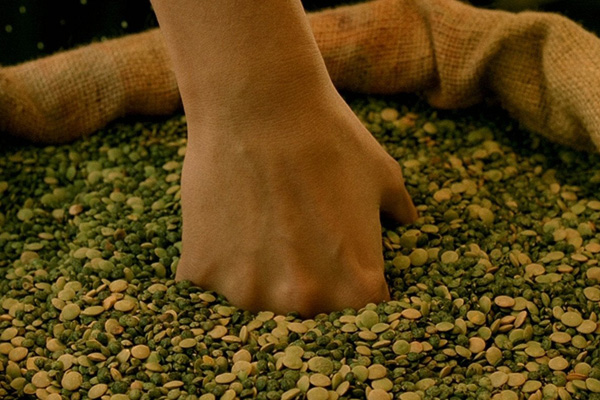
As much as I love Amélie Poulain, I hate thinking of people digging into bulk ingredients with their bare hands… Thankfully, many stores are now moving to dispenser-style bins that also keep the provisions sheltered from ambient oxygen.
What vegan ingredients are (likely) better packaged
Something I never buy in bulk is flour. Not only it is messy to transfer to most reusable containers, but it goes rancid quickly from air exposure, losing some of its micro-nutritional value. I prefer to buy small bags of the most-local flour I can find. The bags are generally paper, so at least they are recyclable (or compostable if soiled). If I need oat flour, I always process it from rolled or steel-cut oats with my Vitamix blender. Doing the same for wheat flour from whole kernels would theoretically be possible, but I haven’t done it yet.
Unfortunately, many other ingredients we consume on a regular basis can go rancid or otherwise spoil if they aren’t carefully stored. Even before I start worry about hygiene, the “box” type of bulk bins that opens from the top accelerates the oxidation of many ingredients’ nutrients. Naturally-oily foods like nuts and seeds can go rancid pretty quick – and at that price point it’s doubly wasteful. Dispenser-style bins are less prone to contamination and likely also reduce oxidation, but who knows when they are cleaned? Hygiene aside again, the oil residue from, say, walnuts, accumulate on the sides of the containers and eventually go bad, contaminating the whole content of the bin.
I am very lucky here in Vancouver (Canada) to have access to a couple of high-quality zero-waste bulk stores that refill my containers. They source high-quality products that are organic and often local and/or ethically produced too… which means that I don’t go there to save money. Their storage containers seem very clean and stock rotates quickly. When I can afford to shop from there (in both money and time), I do get nuts and seeds from them.
If I cannot source bulk nuts and seeds from a reputable source, then I prefer to buy them packaged in airtight plastic bags, which have a lesser total waste weight compared to hard-sided plastic containers.
Staples that are easy to make at home
Much of our packaging waste comes from convenience items that have been pre-made for us in large factories and packaged into plastic containers, glass jars, metal cans, or multi-layer cartons. Many of those can be made at home in 5 minutes or less! The longest step is often washing the resulting dishes! As you get more skilled and making your own staples becomes routine, you’ll become more efficient and create fewer messes. And, best of all, your grocery bags will be lighter to carry home! (That’s a big bonus if you travel by foot or by bike.)
Need milk? All you need is a (powerful) blender to make a creamy beverage from oats, cashews, cooked rice, soy beans, and more. Even if the basic ingredients come to your home in a package, it’s still far less wasteful than buying cartons of plant milk.
(When baking, no need to use plant milk from a carton! Just throw the water and a handful of seeds or nuts in the blender. Done! With bonus fiber.)
Love meat alternatives? Try your hand at making seitan from vital wheat gluten! It’s way easier than you think. Vital wheat gluten is sometimes available in bulk although depending on your area stock may rotate only slowly.
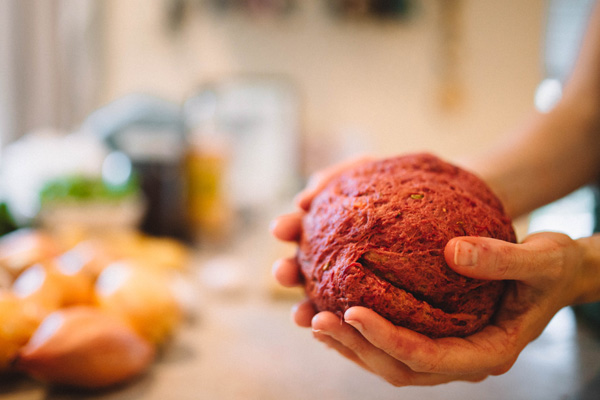
Homemade seitan can be made zero-waste, and it’s easier than you think!
Miyoko Shinner’s book The Homemade Vegan Pantry offers recipes to make all the meat and dairy analogs you can think of, and more! She includes many gluten-free options. If you consume a lot of yogurt, you’ll want to check out her recipes. I don’t often make it myself, but when I do I love using my Instant Pot‘s yogurt function because it keeps the jars at a constant temperature and safe from accidental knocks that could result in spills.
You can even make a simple yet delicious cheesy spread from tofu following these instructions from my friend Tosha at the Peace People Project.
Nut and seed butters can be blended smooth in a minute at home if you have a high-power blender (like a Vitamix or Blendtec). Even if you get your nuts from a plastic bag, at least you save a jar (which requires much more energy to create).
The vegan snack par excellence, hummus, is also very simple to make at home – the hardest part is cleaning the darn food processor! If using a high-power blender, you could add whole sesame seeds instead of tahini (which is really sesame seed butter), but don’t attempt this in a food processor. Even if you end up buying one jar of tahini, it will last you a few batches of hummus, which is better than buying a tub of hummus every week.
Many vegan staples can be frozen for later use, so you can spend one weekend per month making big batches.
Choosing between glass and plastic when it comes to packaged foods
Plastic has a really, really bad reputation in the zero-waste crowd, and I agree it is a pest. It keeps on breaking down into smaller and smaller pieces that are increasingly hard to capture, and never biodegrade. Some say there will be more plastic than fish (by mass) in the oceans by 2050 and there is probably some truth to that. Fishing nets constitute the bulk of plastic pollution in the oceans, but a lot of the plastic slowly cooking in open-air Asian “material recovery” and breaking down in international waters, can be traced back to North American recycling bins. It’s awful, awful, awful.
“Refuse” and “rethink” should always be our first steps. But once we make the conscious decision to buy something packaged, if we have a choice between two products, should we always pick the one that comes in glass? I say no.
Let’s take yogurt. There’s been a bit of a craze in Canada with a new brand of yogurt with vegan options that came in those really cute but tiny glass jars. Apparently, tiny glass jars pull at shoppers’ heart strings as effectively as puppies: everyone wanted them, and convinced themselves they could reuse the jars for crafting or some other creative use. Matching plastic lids are even available right there next to the yogurt shelves at the supermarket! Marketing genius. But… how many 4-oz jars of yogurt does the average yogurt-lover go through in a week? A month? A year? I can think of uses for 4, 8, maybe 16 of those jars. But what about 100? How big of a home does one need to have to keep that many jars for future projects… that are unlikely to ever come to fruition?
Trend-savvy marketers are aware of the zero-waste movement’s appeal, but let’s not allow ourselves to be played so easily. Producing and transporting glass containers generates much more emissions than plastic equivalents. In reality, only a minuscule fraction of the glass jars the average North American family buys every year get reused, while only about 1/3 get recycled. And when it is recycled, it requires a lot of energy to do so. Moreover, glass’ breakability means that more products may be wasted before they reach consumers.
Plastic yogurt tubs may be less fashionable, but one could argue they are less damaging for the environment.
At the end of the day, the solution is to avoid single-use and packaged items as much as possible. In many cases, it might mean a shift in our habits. Personally, I love plant-based yogurt, but the wasted containers turn me away. I wish I could make it at home more often, but it just doesn’t fit my lifestyle at the moment. I enjoy overnight oats in home-made soy milk just as much, so that’s what I have for breakfast. I enjoy yogurt as a treat on occasion.
What about drinks?
Look at your recycling bin: what takes the most space? I bet it’s drink containers.
I’m not sure how beverage companies have managed to ingratiate themselves so deeply into North American families, but there you are: everyone seems to be drinking something (other than water) all the time, and the resulting waste is mind-boggling.
Personally, I prefer plain tap water – Capilano Tonic, ice cold, please! But my husband has a thirst for carbonated drinks. As the grocery shopper I hated dragging the cans uphill from the store, to say nothing of the overflowing recycling bin. We managed to reduce the amount of single-use containers we go through by buying a Sodastream machine that lives on the countertop. (The gas cartridges get exchanged at the store and reused many times.) He’s taken to drinking it plain, but there are many homemade syrup recipes you can find online. (And if you want to buy a Sodastream, consider buying the no-frills model without batteries, which should be easy to find on the second-hand market.)
Kitchen cleaning products
All of my kitchen cleaning is done with either plain dishsoap or a solution of vinegar and water that I put in a spray bottle. Both dishsoap and vinegar are available at our refill store, thankfully. They also refill our dishwasher powder. If you can find such a store in your city, you’re golden. (Check these directories for the USA and Canada respectively, and please share your favorite stores in the comments!)
Zero-waste kitchen products I use (and those I don’t)
Mason jars are the working horses of my pantry organization system. For the most part they are for room-temperature and refrigerator storage. The only ones I use in the freezer are the 2-cup straight-wall ones. I use exclusively wide-mouth styles in various sizes. Perhaps 2 or 3 per year break one way or another, so it’s not a fool-proof system. Be aware that the two-part metal lids are airtight, but the white plastic ones are not and can leak.
Leftovers, batch cooked meals, and prepped components of future dishes are usually stored in rectangular glass containers with snap-top plastic lids. I get the latter from IKEA because I can easily replace parts if the containers break or lids go missing (or reincarnated into single socks). They are freezer friendly and more space-efficient than round ones.
Labels. Lots of labels. Knowing what’s in there increases the likelihood that it gets eaten instead of wasted!
We haven’t bought paper towels in years. We use a combination of tea towels (lovingly woven by my aunt), rags, and cloth napkins. No need to buy anything new (to you)! Church rummage sale tables are piled high with beautiful kitchen linens of all types.
My husband’s coffee gets made in an automatic espresso machine. We had a cheaper semi-automatic machine before and it was great too. The single-use coffee pods are so pointless, it blows my mind. No wonder the original inventor regrets creating them in the first place!
We have a set of stainless steel metal straws to prevent smoothie moustaches. The energy required to create a single stainless steel straw is equivalent to the manufacturing of about 150 straws, so there is no point in buying those if they get lost after a few uses. I follow their whereabouts like a hawk.
When out and about, I carry our own cutlery in a repurposed pencil case, along with a few cloth napkins and metal straws (although I am very wary of losing those). But usually it’s… “disposable” but sturdy plastic cutlery. Despite our efforts to avoid single-use items, we often end up using some when we are on the go, so we keep them, wash them, and reuse them. That’s what I use for the kids’ lunches, too. Over 90% of the time, those forks and spoons come back, but if they get lost, no big deal… whereas I would go bonkers if my “good” cutlery went missing. In the past, I succumbed to the cuteness of a cute set of metal “travel” cutlery with a carrying pouch… which broke into pieces after less than a dozen uses. Lesson learned: just use what’s at hand instead of buying dedicated “zero-waste” items.
I do not use beeswax wraps. I generally avoid bee-derived items, but a few years back I was gifted a couple of those wraps and tried them out. Despite my best efforts, they lost their waxiness within a few months. (I suspect it had something to do with my household’s other dishwasher, a.k.a. husband, using hot water on them.) I keep thinking I should follow these instructions to make some vegan food wraps, but really I don’t need them. I just put food in containers with a lid and call it the day. I do have one roll of plastic wrap that I use very sparingly – it’s kind of small yet I have had it for over a year. When it runs out, I may not replace it.
Obviously, I use reusable shopping bags, and throw them in the wash every once in a while. (Probably not often enough.) I hate how many stores have taken to freely distributing reusable shopping bags with their brand, as the bags’ environmental footprint is significant and they are already over-abundant.
I also have about a dozen fabric and mesh bags of various sizes for bulk items and produce. This said, produce seldom actually needs to be bagged. There is no reason why mangoes and apples can’t fraternize in a shopping bag. I throw those in the wash after nearly every use.
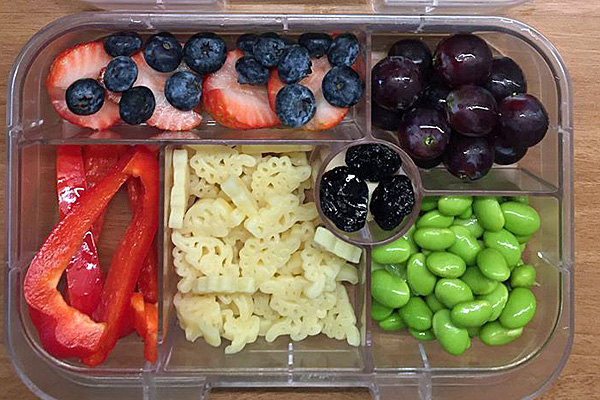
A zero-waste lunch in my kids’ Yumbox tray.
Zero-waste lunches
Using a bento-style box for the kids’ lunches is first and foremost a mental health decision. But the divided containers also allow us to use little to no packaged, processed foods. For their noon-hour meal, my kids enjoy a combination of raw or cooked ingredients that we commonly eat, like beans, grains, veggies, and fruit. They are picky eaters who don’t like “foods that touch” anyway, so keeping each item separated from the others is perfect for them.
My children are currently 8 and 4. Although we do own stainless-steel Planet Boxes (the Rover kind with 5 compartments), both kids still bring their plastic Yumbox to school most days. I find that the Rover is a little too big for their appetite, but if I put less food in there it looks sad. Moreover, the Rovers take more real estate on the lunch table, whereas the Yumbox lids can stay up when open, making it easier to share a table with 20 friends. The Yumboxes are very durable, and the inner trays can go in the dishwasher (although we prefer just washing them by hand).
As for adults, we tend to eat leftovers for lunch. We just prep them as we clean up the kitchen in the evening, transferring cooked food from cooking vessels to rectangular glass containers (or occasionally Mason jars). My husband often rides his bike to work and prefers not to carry a bag, thus he often transfers his lunch to a zip-top bag. Those get reused a few times but eventually the edges tear up and they have to go. If anyone knows of a really durable and really airtight but soft-sided solution to replace zip-top bags, I would love to know. I have owned a few different brands of silicon alternatives, but none was durable enough to justify the investment – which in the end means it’s more wasteful.
We do have a few zippered pouches for snacks, too, so we don’t need to use plastic wrap.
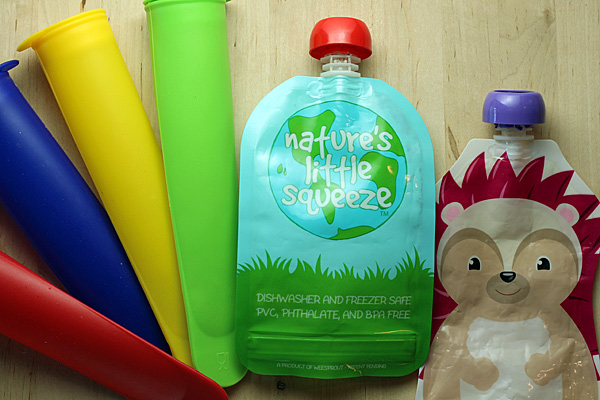
Kids love frozen treats. The silicon tubes are great for home-made freezies. I pour thick smoothies into the reusable pouches. My kids love finding those in their lunches!
Keeping the big picture in mind
Going vegan? Easy! Going zero-waste? Wow. Living even a mostly zero-waste life in our modern society is a struggle… unless we make a conscious effort to make it a priority, and make the rest of our lives’ decisions accordingly. For most of us, going zero-waste in the kitchen cannot be done without making substantial lifestyle changes, including eating a simpler diet, shopping from stores with well-stocked bulk sections, and prioritizing cooking from scratch.
What the planet needs now is more imperfect vegans, and also more imperfect zero-wasters.
Love it? Pin it!
